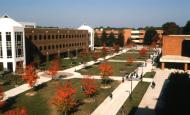
|
|
||
   College of Science CAMP Home People └ Alumni ├ J. Lindeman, PhD ├ J. Bakosi, PhD ├ E. Novakovskaia, PhD ├ N. Ahmad, PhD ├ J. C. Chang, PhD └ F. Camelli, PhD Research Simulation gallery Publications Resources for students Data archive Annual conference Computing resources Related links About our webpage Contact us |
Fernando Camelli, PhDYear of graduation: 2002 Degree: Doctor of Philosophy, Computational Sciences and Informatics Research field: Urban-scale atmospheric transport and dispersion, computational fluid dynamimcs Thesis title: Study of atmospheric dispersion at building and street scales Thesis abstract: This research study is concerned with the atmospheric flow and dispersion of pollutants around one building or a group of buildings using Computational Fluid Dynamics (CFD) methods. A CFD simulation consists of three main stages: preprocessing, solution and post-processing. The present research effort has resulted in contributions for each of these stages. The pre-processing stage was improved via a new algorithm to merge discrete surfaces. Several modifications to surface merging procedures which are based on the extraction of iso-surfaces from a distance map (defined on an adaptive background grid) are presented. This new algorithm is adaptable to computer aided design (CAD) representation for buildings because it preserves the original geometry with sharp edges and corners. The iso-surface extraction algorithms are modified to obtain the correct iso-surface for multi-component objects. This algorithm allows realistic modeling of a large number of complex engineering geometries, using overlapping components defined discretely, i.e., via surface triangulations of buildings and terrain data. This model is very useful for grid generation starting from data originated in measurements or images. In the solution stage, this work studies the calculations of flow around an L-shaped building. This example used Large Eddy Simulation (LES), and the Euler Equations. The numerical results are compared with wind tunnel data. The time requirements of the solution stage are also addressed via implicit solvers and parallel processing. The turbulence problem is analyzed and the lack of accuracy in these models is addressed. A new turbulence model is presented, using a combination of the Baldwin-Lomax and Smagorinsky turbulence models, to compensate for the deficiencies of each one of these simple models. Results obtained for a sphere, a cylinder, and a cube indicate that the proposed model yields acceptable results, and represents an attractive alternative when transient simulations with wall effects can not be performed with either RANS or LES. For the post-processing stage, standard deviations for velocity fluctuations are monitored and then used in comparisons with experiments. In particular, for the flow past the LPD-17 ship, the use of velocity averages and standard deviation leads to increased credibility of the numerical results. Current employment: George Mason University, Center for Fluid Dynamics Current activities: Transport and dispersion of pollutants in the atmosphere: urban scale problems, dispersion around buildings, Turbulence Modeling for CFD: Large Eddy Simulations, Wall models for bounded flows, Unstructured Grid Generation, Parallel Computing Personal website: http://www.scs.gmu.edu/~fcamelli See the CAMP
contact page for detailed
information on contacting us. |
|
